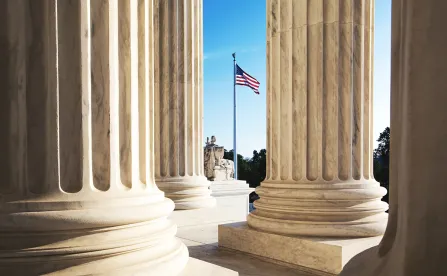Greetings, Court Fans!
And Happy Election Day! No doubt, there may be other things on your mind this evening, but if you’re looking for a diversion as the results trickle in, you’re in luck, as we’ve got the first two opinions of the term to share with you! And in case you’re not looking for a diversion, you’re still in luck, as we’ve also got a round-up of the Court’s recent election decisions.
The first two opinions of OT20 were both per curiam GVRs, each notable in its own way. In Taylor v. Riojas (No. 19-1261), the Court flipped the usual script and vacated a lower court judgment granting qualified immunity to prison officials sued by an inmate violating the Eighth Amendment. Trent Taylor alleged that, for six days in September 2013, corrections officers including Robert Riojas confined him in a pair of “shockingly unsanitary cells.” That’s an understatement—the first cell was “covered, nearly floor to ceiling, in massive amounts’ of feces,” and the second was “frigidly cold” and “equipped with only a clogged drain in the floor to dispose of bodily wastes.” When Taylor involuntarily relieved himself in Cell 2, the drain overflowed and raw sewage spilled across the floor. And because the cell had not bunk and Taylor was confined without any clothing, “he was left to sleep naked in sewage.” The Fifth Circuit held that these conditions of confinement violated the Eighth Amendment but, in a familiar sequence, concluded that “the law wasn’t clearly established” that “prisoners couldn’t be housed in cells teeming with human waste” “for only six days,” and therefore granted the defendants qualified immunity.
The Supreme Court reversed, 7-1 (with Justice Barrett on the bench). In a brief per curiam opinion, the Court held that “no reasonable correctional officer could have concluded that, under the extreme circumstances of this case, it was constitutionally permissible to house Taylor in such deplorably unsanitary conditions for such an extended period of time.”
So shocking were these conditions that even Justice Alito concurred in the judgment vacating and remanding for trial. But, in his view, the Court never should have granted certiorari in the first place. Whether a reasonable corrections officer would have known that it was unconstitutional to confine Taylor under the conditions alleged, Alito argued “is a quintessential example of the kind [of question] that we almost never review.” (This, it bears noting, is a variation of the argument heard by dissenting judges when the Court summarily reverses lower court refusals to grant qualified immunity.)
Justice Thomas alone dissented, but—also strange in this day and age—provided no written reason for his vote.
Justice Thomas was also the lone holdout in Mckesson v. Doe (19-1108), where he once again dissented without opinion. (The two one-word dissents sparked some concern on the Twitterverse that Justice Thomas might be unwell, though his active participation in oral argument over the last two days dispelled that fear. Maybe he’s just worn out from having to ask so many questions during the new remote argument format!)
Mckesson is a case arising out of the Black Lives Matter protests that have erupted throughout the country over the last few years in response to police shootings. DeRay Mckesson organized one such protest in Baton Rouge, Louisiana, where protesters (allegedly at Mckesson’s direction) occupied the highway in front of police headquarters. As officers began making arrests to clear the highway, an unknown individual (not Mckesson) threw a “rock-like object,” which struck Officer Doe in the face, causing devastating injuries. Unable to identify the culprit, Officer Doe sued Mckesson on the theory that he negligently staged the protest in a manner that caused the assault. The District court dismissed the claim as barred by the First Amendment, but a divided panel of the Fifth Circuit reversed, holding that a jury could plausibly find that Mckesson had breached his “duty not to negligently precipitate the crime of a third party” because “a violent confrontation with a police officer was a foreseeable effect of negligently directing a protest” onto the highway.
The Supreme Court vacated and remanded (again in a 7-1 per curiam opinion, with Barrett sitting out). The Court did not hold that the Fifth Circuit was necessarily wrong to reverse, but rather that it shouldn’t have ruled without getting clarification from the Louisiana Supreme Court on an issue of state law. As the majority pointed out, the First Amendment question at the heart of the case is only implicated if in fact Louisiana law permits recovery for negligently directing a protest in the first place. Like other states, Louisiana does not recognize a “duty to protect others from the criminal activities of third persons.” The Fifth Circuit panel majority recognized this, but concluded that Mckesson could be found liable if it was foreseeable that his decision to direct protesters to occupy the highway would lead to violent confrontation. The Supreme Court felt that that interpretation of state law was “too uncertain a premise on which to address the [constitutional] question presented.” Instead, it vacated and directed the Fifth Circuit to certify to the Louisiana Supreme Court the question whether state law permitted recovery under these circumstances.
What’s particularly interesting about Mckesson is that it suggests there are times when certifying a question to a state court is required—or at least that is would be an abuse of discretion not to do so. Here, while the majority acknowledged that certification is generally not required (and even discouraged, as it creates additional burdens for the parties and state courts), it concluded that certification was necessary here, essentially to avoid having to decide an important constitutional question on an uncertain state-law predicate. “[T]he Fifth Circuit should not have ventured into so uncertain an area of tort law—one laden with value judgments and fraught with implications for First Amendment rights—without first seeking guidance on potentially controlling Louisiana law from the Louisiana Supreme Court.”
While Taylor and Mckesson are the first opinions of the Court this term, there have been a surplus of chambers opinions in the early going. We don’t normally cover every order of the Court that prompts an opinion, but in honor of Election Day, a few words on the Court’s controversial decisions in election-law cases is in order. As our non-troglodyte readers are probably aware, the Court has intervened in a number of ballot challenges, in South Carolina, Alabama, Wisconsin, North Carolina, and Pennsylvania. Many of these cases involve state or local efforts to facilitate voting in light of the challenges posed by the COVID-19 pandemic (e.g. by extending absentee-ballot deadlines). Challengers (generally Republican interests) have contested these efforts as violating Article II, Section 1 of the Constitution, which provides that each State’s legislature shall set the manner of choosing electors for president and vice president. The idea that the federal constitution may prevent state courts or election boards from changing voting rules—having first gained some traction in a concurring opinion Bush v. Gore—remains controversial, and it has created some interesting fissures among the Justices (some of whom were involved as lawyers in that epochal election case). Rather than summarize the background and holding of each state, we thought we’d offer a 10,0000-ft. view of some patterns that have merged in the Justices’ voting—courtesy of our in-house election expert, Shai Silverman—juuust in case similar issues arise after this evening:
Justices Alito, Thomas, Gorsuch, and Kavanaugh have consistently that only state legislatures can impose alterations on election procedures, particularly this close to an election. In Pennsylvania, for example, an existing statute required all mailed ballots to be received by 8 p.m. on election day. The Supreme Court of Pennsylvania, however, decreed that mailed ballots would be counted so long as they were postmarked by that deadline. The Republican Party sought relief, but the Supreme Court refused to stay that decree or grant a motion for expedited certiorari consideration. Justice Alito, with Justices Thomas and Gorsuch joining, wrote that the Pennsylvania Supreme Court’s decree likely violated Article II, Section 1. Justice Alito wrote that the election in Pennsylvania would now be “conducted under a cloud,” and noted that the ballots could still be segregated so that, if the Court did ultimately grant certiorari, the ballots in question could be easily identified. Similarly, in North Carolina, the General Assembly implemented new election laws designed to make voting easier by mail, including reducing the witness requirement for absentee ballots from two to one. But the State Board of Elections went further, extending the absentee ballot receipt deadline from November 6 to November 12. Again, the Supreme Court refused to enjoin the deadline extension. Justice Gorsuch, joined by Justice Alito (Justice Thomas would have allowed the relief but did not join the opinion) argued that the Court should have enjoined the deadline extension. He maintained that the Board of Elections effectively acted ultra vires when it enacted the extension, and that only the General Assembly itself had authority to do so. Justice Gorsuch further warned that “last-minute changes by largely unaccountable bodies . . . invite confusion, risk altering election outcomes, and in the process threaten voter confidence in the results.
Justice Kavanaugh has written less than his conservative colleagues, but one opinion he has written was a doozy. In D.N.C. v. Wisconsin State Legislature, Wisconsin had decided to keep its Election Day deadline for receipt of absentee ballots. A federal district court intervened, requiring the State to extend its deadline by six days. The Seventh Circuit stayed that ruling, and the Democrats asked the Court to vacate the stay. The Court declined to do so. Justice Kavanaugh wrote a lengthy opinion (joined by Justice Gorsuch), that has garnered significant attention. The majority of the opinion echoes similar points made in the cases described above: alterations of election rules this close to the election risks too much voter confusion and can interfere with fair electoral administration; it should be up to state legislatures, not federal courts, to decide how to best conduct their own elections during the pandemic; and electoral deadlines are necessary and the line must be drawn somewhere – the deadline does not become improper simply because voters chose to procrastinate. What has caused some consternation is not these broad points, but rather a footnote in Justice Kavanaugh’s opinion, in which he cited to Justice Rehnquist’s concurrence in Bush v. Gore for the proposition that a “state court’s significant departure from the legislative scheme for appointing Presidential electors presents a federal constitutional question,” such that federal courts are empowered to “ensure that state courts do not rewrite state election laws.” In addition to the Bush v. Gore citation, Justice Kavanaugh’s opinion has generated additional controversy due to his echoing statements by President Trump to the effect that mailed ballots can cause “chaos and suspicions of impropriety . . . if thousands of absentee ballots flow in after election day and potentially flip the results of an election.” Finally, the opinion contained a mistake: Justice Kavanaugh cited to Vermont as an example of a state that “decided not to make changes to [its] ordinary election-deadline rules,” which was not true: Vermont has actually changed its rules with respect to processing mailed ballots prior to Election Day, for example. Vermont’s Secretary of State publicly said as much, causing Justice Kavanaugh to issue a correction.
Chief Justice Roberts: The Chief Justice has taken a different approach from the other conservatives. For him the relevant question is who is one of pure federalism: he does not believe that federal courts should meddle in the electoral affairs of the States but believes that state courts are empowered to apple their own constitutions to election regulations. Thus, in the Pennsylvania case the Chief sided with the liberals in refusing review the State Supreme Court’s ruling. In Wisconsin, by contrast, Chief Justice Roberts joined with the conservatives, noting that, where as the “Pennsylvania applications implicated the authority of state courts to apply their own constitutions to election regulations, [the Wisconsin] case involves federal intrusion on state lawmaking processes.” The former is acceptable; the latter is not. Interestingly, although the Chief appears to be alone in this view on the Court, he has nevertheless cast the decisive vote applying these principles in these key election cases.
Breyer, Kagan, Sotomayor: The three liberal Justices have spoken with one voice when it comes to all of these cases: They would vote in favor of expanded voting opportunities, given the “severity of the COVID-19 pandemic.” In the Wisconsin case it was Justice Kagan who dissented (joined by the other two), writing that, given the “emergency conditions” of the pandemic and the ways in which “COVID would affect the electoral process in Wisconsin,” it was proper for the district court to extend the ballot receipt deadline. Justice Kagan took issue with the Seventh Circuit’s singular focus on the fact that the change happened so close to the deadline, noting that not every change to election mechanics carried with it a fear of voter confusion. For Justice Kagan, it was “hard to see how the extension of a ballot-receipt deadline could confuse citizens about how to vote: At worst, a voter not informed of the new deadline would (if she could) put her ballot in the mail a few days earlier than needed.” Justice Kagan also took issue at length with Justice Kavanaugh’s concurrence, writing that his analysis failed to give the district court’s findings about the dangers of COVID “the respect they are due,” and that his analysis improperly “reasons from normal, pre-pandemic conditions.” Or Justice Kagan, in light of the pandemic, sticking to the original ballot receipt deadline would impermissibly disenfranchise voters, such that the district court was right to impose an extended deadline that would allow all votes to be counted.
There is one other case that has received less press attention but also triggered a dissent from Justice Sotomayor (again, joined by the two other liberals). In Merrill v. People First of Alabama (No. 20A67), the district court enjoined the Alabama secretary of state’s decision to ban curbside voting, the Eleventh Circuit let the injunction stand, but the Court stayed the injunction, thus enabling the ban on curbside voting. Justice Sotomayor’s dissent noted that the CDC recommends curbside voting, and that the DOJ has previously sanctioned curbside voting as a way to remedy ADA violations at polling places. Indeed, discrimination was central to Justice Sotomayor’s analysis: In her view, the district court’s ruling that the ban on curbside voting violated the ADA was correct, because the ban “deprives disabled voters of the equally effective opportunity to participate in the benefit of in-person voting.” She would have therefore required Alabama to let voters vote curbside.
Justice Barrett: To date, Justice Barrett has not participated in any of these key electoral decisions. A court spokesperson said that was “because of the need for a prompt resolution” and “because she has not had time to fully review the parties’ filings.” Of course, the President has suggested on more than one occasion that Justice Barrett must be confirmed in case the Supreme Court had to decide a contested election. Not that she’s finished her orientation, it will be interesting to see which camp Justice Barrett falls into—or alternatively, whether she decides to recuse herself.
That’ll do it for now. With any luck, we won’t have consequential election decisions to review in the coming weeks, but we’re not counting on it. In the meantime, take comfort in the fact that, while there may be some skirmishes over the outcome of this election, at least we live in a country where we don’t know that outcome in advance.





 />i
/>i
